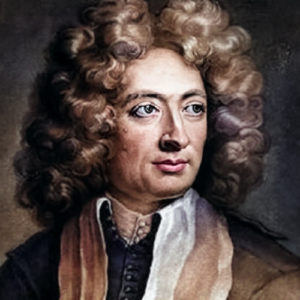Arcangelo Corelli

Arcangelo Corelli (1653 – 1713) was an Italian violinist and composer known chiefly for his influence on the development of violin style and for his sonatas and his 12 Concerti Grossi, which established the concerto grosso as a popular medium of composition.
Corelli’s mother, Santa Raffini, having been left a widow five weeks before his birth, named him after his deceased father, Arcangelo. There are no documented details on his first years of study. It is thought that his first teacher was the curate of San Savino, a village on the outskirts of Fusignano. Later, he went to Faenza and Lugo, where he received his first elements of musical theory. Between 1666 and 1667 he studied with Giovanni Benvenuti, violinist of the chapel of San Petronio in Bologna. Benvenuti taught him the first principles of the violin, and another violinist, Leonardo Brugnoli, furthered his education. In 1670 Corelli was initiated into the Philharmonic Academy of Bologna.
After a four-year stay in Bologna, Corelli went to Rome. Reliable evidence on his activities is lacking for the first five years, but it is likely that he played the violin at the Tordinona Theatre. Also, it is possible that in 1677 he made a trip to Germany, returning to Rome in 1680. On June 3, 1677, he sent his first composition, Sonata for Violin and Lute, to Count Fabrizio Laderchi of Faenza.
By Feb. 3, 1675, he was already third violinist in the orchestra of the chapel of San Luigi dei Francesi, Rome, and by the following year he was second violinist. In 1681 his 12 Trio Sonatas for Two Violins and Cello, with Organ Basso Continuo, Opus 1, dedicated to Queen Christina of Sweden, who had a residence in Rome, were published. The following year he took the post of first violinist in the San Luigi dei Francesi orchestra, a position he held until 1685, the year in which his 12 Chamber Trio Sonatas for Two Violins, Violone and Violoncello or Harpsichord, Opus 2, were published.
From September 1687 until November 1690, Corelli was musical director at the Palazzo Pamphili, where he both performed in and conducted important musical events. Corelli was particularly skilled as a conductor and may be considered one of the pioneers of modern orchestral direction. He was frequently called upon to organize and conduct special musical performances. Perhaps the most outstanding of these was the one sponsored by Queen Christina for the British ambassador, who had been sent to Rome by King James II of England to attend the coronation of Pope Innocent XII. For this entertainment, Corelli conducted an orchestra of 150 strings. In 1689 he directed the performance of the oratorio Santa Beatrice d’Este by Giovanni Lulier, called del violino, also with a large number of players (39 violins, 10 violas, 17 cellos, and additional instruments to make a total of more than 80 musicians). The same year, he entered the service of Cardinal Pietro Ottoboni, in which he spent the rest of his life.
In 1689 Corelli’s 12 Church Trio Sonatas for Two Violins and Archlute, with Organ Basso Continuo, Opus 3, dedicated to Francesco II, duke of Modena (he had been the Modenesi Count, 1689–90), was published; and in 1694 his 12 Chamber Trio Sonatas for Two Violins and Violone or Harpsichord, Opus 4, intended for the academy of Cardinal Ottoboni, also appeared.
Special 67% offer for students! Finish the semester strong with Britannica.
It is probable that Corelli also taught at the German Institute in Rome and certain that in 1700 he occupied the post of first violinist and conductor for the concerts of the Palazzo della Cancelleria. Also in 1700 his 12 Sonatas for Violin and Violone or Harpsichord, Opus 5, dedicated to Sophia Charlotte of Brandenburg, was published.
In 1702 Corelli went to Naples, where he probably played in the presence of the king and performed a composition by the Italian composer Alessandro Scarlatti. There is no exact documentation for this event; however, it is known that he met George Frideric Handel, who was in Rome between 1707 and 1708. In 1706, together with the Italian composer Bernardo Pasquini and Scarlatti, he was received into the Arcadia Academy and conducted a concert for the occasion.
Corelli did not live to see the publication of his Opus 6, consisting of 12 concerti grossi, which was published in Amsterdam the year following his death.
Baroque Saxes: Book 3 Duets/Trios, Corelli, Grade 3+– – – – –
The Occasional Organist’s Survival Kit Book 5– – – – –